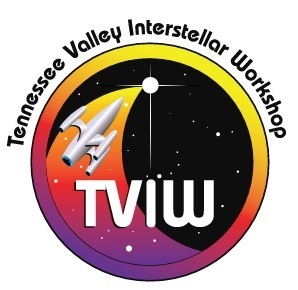Paul Gilster's Blog, page 179
April 24, 2015
Habitable Worlds Around Tau Ceti?
Yesterday’s look at NExSS (the Nexus for Exoplanet System Science), NASA’s new ‘virtual institute,’ focused on the multidisciplinary nature of the effort. The work I’m looking at today, an analysis of the planets around Tau Ceti performed at Arizona State University, only emphasizes the same point. To get a read on whether two planets that are possibly in Tau Ceti’s habitable zone are likely to be terrestrial worlds like Earth, the ASU team brought the tools of Earth science into play, in particular the work of Sang-heon Shim.
Shim is a mineral physicist who worked with astrophysicists Michael Pagano, Patrick Young and Amanda Truitt in the Tau Ceti analysis. His perspective was vital because early work had already suggested that Tau Ceti has an unusual balance between the rock-forming minerals magnesium and silicon. In fact, the ratio of magnesium to silicon here is 1.78, about 70% more than we find in the Sun. That casts long-standing views of Tau Ceti as Sol’s twin into doubt, and raises questions about the nature of the planets that formed around it.
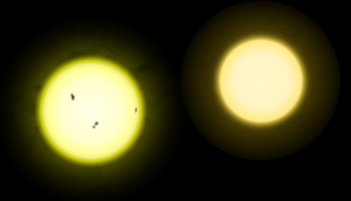
There is evidence for five of these, with two — Tau Ceti e and f — thought to be in the habitable zone. That’s an attractive possibility, for Tau Ceti is nearby at 12 light years, a solitary G-class star like the Sun, and a relatively stable one at that. No wonder it figures prominently in science fiction, its very proximity made a significant plot issue by Larry Niven in his 1968 novel A Gift from Earth, which depicts an isolated Tau Ceti colony that can still receive the occasional cargo from Earth. Isaac Asimov made a Tau Ceti planet the home of the first human extrasolar settlement in The Caves of Steel (1954).
Image: The Sun is at the left in this comparison with Tau Ceti. Credit: R.J. Hall via Wikimedia Commons.
In fact, I can think of few stars that have received so much attention from writers. Might some of the planets there really be habitable? The two planets we are looking at are ‘super-Earths,’ with masses of 4.29±2.00 and 6.67±3.50 times that of Earth respectively. The new work makes the prospect of Earth-like conditions unlikely. In fact, Shim’s mineralogical study indicates that the high magnesium/silicon ratio of the parent star could produce planets unlike any we’re familiar with, as the scientist explains:
“With such a high magnesium and silicon ratio it is possible that the mineralogical make-up of planets around Tau Ceti could be significantly different from that of Earth. Tau Ceti’s planets could very well be dominated by the mineral olivine at shallow parts of the mantle and have lower mantles dominated by ferropericlase.”
Ferropericlase is a magnesium/iron oxide that is thought to be a major constituent of the Earth’s lower mantle, along with silicate perovskite, which is a magnesium/iron silicate. Because ferropericlase is viscous, an abundance of it in the mantle would make mantle rock flow more readily, possibly affecting plate tectonics and volcanism at the planetary surface. The resulting world would pose challenges for the development of life, and certainly for its detection. “Faster geochemical cycling,” the paper notes, “could impede the buildup of biologically produced non-equilibrium chemical species in the planet’s atmosphere.”
The paper describes what it calls a detectability index, or DI, that gauges the ability of a planet to house life and to maintain biosignatures of the kind we hope to detect with new space telescope missions. Tau Ceti planets in the habitable zone might, in other words, be habitable, but unlikely to produce detectable life signs in their atmospheres. Life would not necessarily be absent, but detecting it would require a thorough study of planetary evolution.
Another issue is the length of time a planet spends in the habitable zone. Tau Ceti e’s position is deeply problematic. The authors believe the world is reaching the end of its habitable lifetime and is at best on the extreme inner edge of the habitable zone. Tau Ceti f, meanwhile, appears to be near the outer edge of the habitable zone, but evidently moved into it within the past 1.5 billion years, and probably in much less time than this.
Assume even a billion years in the habitable zone and bear in mind that Earth’s biosphere took roughly two billion year to produce biosignatures that would be theoretically detectable. The DI for this world — our ability to find life if it does exist on Tau Ceti f — would be low indeed. A long habitable lifetime may be in this planet’s future, but that doesn’t help us now:
Even in the most pessimistic case, the planet will have about 7 Gy of habitable lifetime until the end of the main sequence, plus additional time while the star traverses the subgiant branch. From a detectability standpoint, however, f is a poor candidate. At best, the planet has been in the HZ for <
So we have in Tau Ceti f a world where life could exist but would be, at least according to what we know of life here on Earth, probably in an early state and unlikely to be detectable. There is a significant lesson for us in this conclusion, as the paper goes on to note:
The rate of change of L [luminosity] and Teff [stellar effective temperature] as a function of time means that cases similar to f where a planet enters the HZ in the latter part of the star’s life are more common than planets that have been in the HZ since early times. This serves as a reminder that the present “habitability” of a planet does not necessarily indicate that it is a good candidate for detecting biosignatures. The temporal evolution of the system must be taken into account.
So much, then, for the notion that if we detect a planet in the habitable zone, we are safe in assuming life has had time enough to emerge there. Here we have one case of basic mineralogy casting doubt over whether surface conditions are habitable or whether it could be detected by our instruments if present, and another where the movement of a planet into the habitable zone means that biology may flourish there but only in our distant future.
The paper is Pagano et al., “The Chemical Composition of τ Ceti and Possible Effects on Terrestrial Planets,” Astrophysical Journal Vol. 803, No. 2 (2015), Art. 90 (abstract / preprint).






April 23, 2015
NExSS: A ‘Virtual Institute’ for Deep Space
The Nexus for Exoplanet System Science, or NExSS, is a collaborative initiative from NASA to draw on the collective talent of researchers from ten universities, three NASA centers and two research institutes. Conceived as a ‘virtual institute,’ the effort is both geographically diverse and multidisciplinary in nature, focusing not only on the search for exoplanets but the attempt to analyze planetary environments and find life. Jim Green, NASA’s Director of Planetary Science, explains the concept:
“This interdisciplinary endeavor connects top research teams and provides a synthesized approach in the search for planets with the greatest potential for signs of life. The hunt for exoplanets is not only a priority for astronomers, it’s of keen interest to planetary and climate scientists as well.”
NExSS draws on the collective expertise of its participants in the areas of Earth science, planetary science within our Solar System, heliophysics and astrophysics to create what NASA is calling a ‘system science’ approach aimed at advancing the search for life on exoplanets. The effort will be led by Natalie Batalha of NASA’s Ames Research Center, Dawn Gelino with NExScI, the NASA Exoplanet Science Institute, and Anthony del Genio of NASA’s Goddard Institute for Space Studies. This NASA news release gives a brief summary of the different teams, selected from proposals submitted to the agency, and the subject of their work.

Image: The search for life beyond our solar system requires cooperation across scientific disciplines — the way the UW-based Virtual Planetary Laboratory has been working since 2001. Now, NASA’s NExSS collaboration will take a similarly interdisciplinary approach to the search for life. Participants include those who study Earth as a life-bearing planet (lower right), those researching the diversity of solar system planets (left), and those on the new frontier, discovering worlds orbiting other stars in the galaxy (upper right). Credit: NASA.
Sixteen projects in all have been funded through NExSS, and while I won’t try to go through all of them today, I do want to look at two a little more closely. At UC Berkeley, James Graham is leading a project that will include researchers at Stanford University. The collaboration, says Graham, draws together three different approaches to exoplanet hunting:
Direct imaging: The Gemini Planet Imager, for which Graham is project scientist, began its exoplanet survey at the Gemini South Telescope in November of last year, taking direct images of planets in the infrared.
Doppler methods: UC-Berkeley’s Geoff Marcy perfected the so-called ‘wobble’ technique that measures the effect of planets on the host star to deduce information about these worlds.
The transit method: Planets passing in front of their star as viewed from Earth have been detected in abundance by the Kepler mission, which has found almost 2000 of them.
The goal of the Berkeley project is to study the three methods and their overlap, using not only the Gemini South instrument but also the Keck Observatories in Hawaii and, when it becomes available, the Thirty Meter Telescope planned for a site next to Keck on Mauna Kea. “It is a wonderful confluence of multiple approaches to planet-hunting that allows us to detect planets that are both near and far from the host star,” adds Marcy, a reference to the Gemini Planet Imager’s ability to find worlds in much more distant orbits than transit or Doppler methods. UC-Berkeley’s news release is here.
At the SETI Institute, researcher Hiroshi Imanaka, a specialist in the chemistry of planetary atmospheres, is part of another team selected by NExSS out of the pool of proposals. Imanaka’s focus is on habitable zones, as he explains in this SETI Institute news release:
“One major thrust of the exoplanet community has been to find worlds orbiting in the so-called habitable zone. That’s the range of distances from a star where a planet could have temperatures permitting liquid oceans. However, liquid oceans are not the only condition under which life can exist. Some of the moons of Jupiter and Saturn are examples of places that are not in the conventional habitable zone, but might be nonetheless habitable. We want to take further steps to characterize habitable environments that lie beyond the solar system.”
In keeping with the wide-range encouraged by NExSS, Imanaka’s work draws on planetary science and astrobiology to study Titan in light of the clues it can provide about planets detected by teams like those at UC-Berkeley. His team is made up of Titan specialists who study the moon’s thick, smoggy atmosphere and exotic ethane seas. Whether or not Titan has life today, Imanaka considers it a ‘pre-biotic’ world that is producing the most complex organic compounds we know of outside Earth. The team hopes to tap the expertise of the NExSS network as it considers how conditions on Titan can inform our study of smoggy exoplanet atmospheres.
I’ll turn you back to the NASA news release for a breakdown of the other projects, which include Debra Fischer’s team at Yale working on spectrometers of Earth-detecting precision for nearby stars, Drake Deming’s team at Yale using Kepler data to study exoplanet atmospheres, and Jason Wright’s Penn State team studying ‘hot Jupiter’ atmospheres with a high-precision technique called ‘diffuser assisted photometry.’ The news release offers links to each.
The formation of NExSS comes at a time when we’re still making discoveries from the abundant Kepler data and anticipating future missions like TESS (Transiting Exoplanet Survey Satellite), which will, unlike Kepler, home in on exoplanet possibilities around nearby stars, and the James Webb Space Telescope, which will measure the infrared spectrum of starlight passing through the atmospheres of transiting exoplanets. Both missions are to be launched within the next few years. The Wide-field Infrared Survey Telescope (WFIRST), scheduled for launch in about ten years, will offer wide-field imaging and spectroscopic surveys of the near infrared sky. NExSS exemplifies the multidisciplinary approach necessary to pull all this incoming information together.






April 22, 2015
Project Dragonfly: Design Competitions and Crowdfunding
by Andreas Hein
Centauri Dreams readers most likely know Andreas Hein as the head of Project Hyperion, an effort for Icarus Interstellar to examine the prospects for manned interstellar flight, but he has also written in these pages about the uploading of consciousness. Now working on his PhD at the Technical University of Munich, Andreas today tells us about a new Kickstarter campaign in support of Project Dragonfly. Developing under the auspices of the Initiative for Interstellar Studies (of which Andreas is deputy director), Dragonfly explores interstellar flight at the small scale, and as he explains below, leverages the advances in computing and miniaturization that designers can use to change the paradigm of deep space missions.

Humanity has existed for over 200,000 years. It is only about 200 years since we entered the age of industrialization, and in the last 50 years, we have discovered ways of going to the stars [1]. However, the approaches conceived required spaceships the size of a tanker and massive space infrastructures. Today we live in a time when we may soon have the technological capabilities to launch a spacecraft to the stars, but now the spacecraft may be no bigger than a suitcase. Project Dragonfly is the first design study for an interstellar mission based on a small, laser-propelled spacecraft. In this article, I will explain the background of Project Dragonfly and the rationale for the Project Dragonfly Design Competition and crowdfunding campaign.
Many previous approaches for going to the stars have depended on extremely large and heavy spacecraft, based on propulsion systems like nuclear fusion or antimatter. Existing concepts of fusion-propelled spacecraft are as heavy as skyscrapers. Accelerating all the fuel with the ship until it is exhausted is actually not a very efficient way to get to the stars. Project Dragonfly aims at a different approach: The basic idea is not new – it is, in fact, very old. For centuries, humans have travelled the seas using sailing ships. We also plan to use a sail. But a sail which is made of an extremely thin reflective surface. This sail would be illuminated by a laser beam from a laser power station somewhere in the Solar System [2]. The photons of the laser beam push the sail, just as the wind pushes the sail of a sailing ship. And through this push to the sail, the spacecraft slowly accelerates.
However, as the spacecraft does not use any on-board fuel, it can accelerate to very high velocities in the range of several percent of the speed of light. Furthermore, Project Dragonfly builds upon the recent trend of miniaturization of space systems. Just a few decades ago, thousands of people were involved in developing the first satellite, Sputnik. Today, a handful of university students are able to build a satellite with the same capability as Sputnik, one that is much cheaper and weighs hundreds of times less than the first satellite. Recently, NASA announced a prize for the development of interplanetary CubeSats [3].
We simply think further. What could we do with these technologies in 20 or 30 years? Would it be possible to build spacecraft that can go to the stars but are as small as today’s picosatellites or even smaller? It is time to explore and innovate.
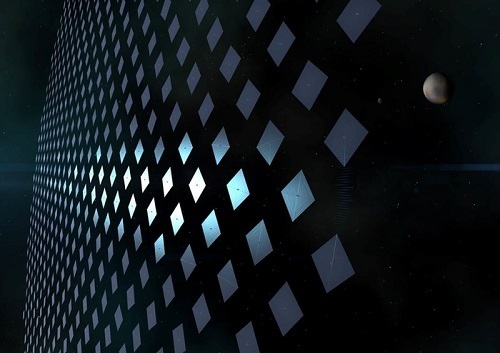
Image: Swarm of laser-sail spacecraft leaving the solar system. Credit: Adrian Mann.
History of the Project
The idea behind Project Dragonfly emerged in early 2013 when I visited Professor Gregory Matloff in New York. Matloff, author of The Starflight Handbook, is one of the key figures in interstellar research with major contributions to the area of solar sails. We talked about different propulsion methods for going to the stars and realized that nobody had yet done a mission design for an interstellar laser-propelled mission. Soon after this conversation, Project Dragonfly was officially announced by the Initiative for Interstellar Studies (i4is), with Kelvin F. Long and myself as co-founders.
However, it took another year to get to the point where we were able to organize an international design competition in order to speed up our search for a feasible mission to another star, based on technologies of the near future. One of the challenges for defining proper requirements for the competition was the development of preliminary mission concepts in order to identify performance drivers and showstoppers. Once these preparations were finished, we could launch the competition. See my essay Project Dragonfly: The case for small, laser-propelled, distributed probes for an early competition announcement and scientific backgrounder.
Why a Competition?
Design competitions have a long tradition in the history of technology: The Longitude rewards for the precise determination of a ship’s longitude at sea (1714), the Daily Mail prize for crossing the English Channel by an airplane (1908), the Orteig prize for crossing the Atlantic with an airplane (1919), and more recently DARPA’s Grand Challenge, which focuses on developing autonomous vehicles (2004). These competitions defined a set of requirements — most importantly performance requirements — the technology would need to fulfill. The solutions were up to the entrants.
Competitions offer the advantage that almost anyone can participate. This opens up opportunities for new entrants and innovative solutions, with the potential to disrupt the existing technological landscape [4]. Of course, with Project Dragonfly we are not yet at the level of the “Grand Challenges”. Nevertheless, the so-called Alpha Centauri Awards were announced by Kelvin Long in 2013, offering several cash prizes for relevant areas in interstellar travel. The Project Dragonfly Design Competition is one of the areas for which the Alpha Centauri Prize will be awarded [5].
The objective of the Project Dragonfly Design Competition is to develop a feasible mission design for a small, laser-propelled interstellar mission. Four international university teams are currently working on studies for small, laser-propelled interstellar spacecraft: Cairo University, the Technical University of Munich, the University of California Santa Barbara (UCSB), and Cranfield University, working with the Skolkovo Institute of Science and Technology (Skoltech) in Moscow and the University Paul Sabatier (UPS) in Paris. The final design reports of the teams will cover all areas that are relevant to make the mission a success and to return scientific data: Instruments, communication, laser sail design, power supply, secondary structure, deceleration propulsion, etc. Furthermore, both technological as well as economic feasibility will be assessed by the teams.

Image: The Project Dragonfly design team at Cairo University, made up of aerospace and communication engineering students, is one of four working on laser sail design.
The teams will meet with members of i4is in London at the headquarters of the British Interplanetary Society this July in order to evaluate their designs. The results from the competition will serve as a basis for future technology development of such a mission.
Project Dragonfly Kickstarter Campaign
The Initiative for Interstellar Studies has now launched the first ever Kickstarter campaign for supporting an interstellar design competition. The funds raised during the campaign will allow us to support the student teams during the competition. The campaign began on the 15th of April and will run until May 14th. All supporters will receive unique and exclusive rewards for their pledges, among them T-shirts and posters with an image of the winning team’s spacecraft, painted by the grand master of space art, David A. Hardy. The campaign is further supported by renowned space artist Adrian Mann. Further awards consist of a 3D-printed version of the winning team’s starship as well as early access to team reports, a signed version of the Beyond the Boundary book edited by Kelvin F. Long, etc.
The campaign can be accessed via:
https://www.kickstarter.com/projects/1465787600/project-dragonfly-sail-to-the-stars
Thanks a lot in advance for your support. Let’s find a way to get to the stars in our lifetime!

Image: An evocative futurescape by space artist David A. Hardy.
References
[1] Dyson, F. J. (1968). “Interstellar transport.” Physics Today, 21(10), 41-45.
[2] Forward, R. L. (1984). “Roundtrip interstellar travel using laser-pushed lightsails.” Journal of Spacecraft and Rockets, 21(2), 187-195.
[3] Staehle, R., Blaney, D., Hemmati, H., Lo, M., Mouroulis, P., Pingree, P., … & Svitek, T. (2011, August). “Interplanetary CubeSats: opening the solar system to a broad community at lower cost.” In CubeSat Workshop, Logan, UT, USA (pp. 6-7).
[4] Calandrelli, E. D. (2013). An evaluation of short innovation contest implementation in the federal context (Masters’ Thesis, Massachusetts Institute of Technology).
[5] Hein, A.M., Project Dragonfly Design Competition website
http://www.i4is.org/news/dragonfly






April 21, 2015
Voyager to a Star?
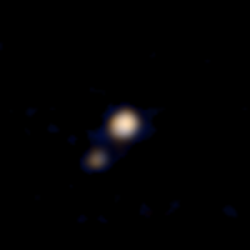
The latest imagery from New Horizons has me wondering what it must be like to be on the team for this mission. Although released a week ago, the photo at left was taken by the Ralph color imager aboard the spacecraft on April 9. The distance from Pluto and Charon in the shot is about 115 million kilometers. This is the first color image ever made of Pluto/Charon by an approaching spacecraft, one that gives us a sense of what lies ahead as the distance continues to diminish. Imagine being part of this long effort and seeing a new world and its system of moons swimming into focus, unveiling landscapes never before seen.
New Horizons takes me back to the Voyager days, and in the context of the approach to Pluto/Charon, the publication of Jim Bell’s The Interstellar Age (Dutton, 2015) is truly apropos (I’m sure the publishers had exactly this in mind). Subtitled “Inside the Forty-Year Voyager Mission,” the book lets us glimpse what it was like inside JPL when the planetary encounters occurred. Bell, now president of the Planetary Society’s board of directors, was caught up in Voyager as a young grad student at Caltech, a formative experience in his career as a planetary scientist. In describing new planets coming for the first time into detailed view, he turns to the words of an old friend:
“The sense of exploration we get with these missions is a very ‘human explorer’ kind of feeling, even though our senses are on the distant spacecraft,” my friend, planetary science colleague, and Voyager imaging team member Heidi Hammel says. “I feel like an old-fashioned mountain climber when I am making discoveries, seeing something for the first time, realizing that no human before me has ever seen what I am seeing. It takes your breath away— for just a moment you feel a pause in time as you know you are crossing a boundary into a new realm of knowledge. And then you plunge in, and you are filled with childlike joy and wonder and delight.”
Hammel goes on to say that you have to temporarily shelve that feeling if you’re a scientist working on the mission, at least while an active encounter is going on. But the wonder of the event is something you always have with you, and it’s something a good scientist wants to share. It’s interesting in the New Horizons context that Bell talks about Jon Lomberg’s One Earth: New Horizons Message project. What Lomberg has in mind for New Horizons, you’ll recall, is an uploaded message, a Voyager ‘Golden Record’ sent digitally into the spacecraft’s computer memory after its Solar System work is done (see New Horizons Message Update].
Could we do something like this for the Voyagers? It’s an intriguing notion. Lomberg pointed out to Bell that while the Golden Record will always be a part of Voyager, there is nothing on the spacecraft that tells of its remarkable passage through our Solar System, something that says ‘here’s what Voyager was and here’s what Voyager found.’ Bell would like to see us upload some of these historic photos. Imagine: The volcanoes of Io, the spectacular cliffs of Miranda, the bizarre cantaloupe terrain of Triton, all could be used to create what he calls an ‘electronic postcard’ that will complete the Voyager story for any future intelligence that finds them.
And is a trajectory change a possibility? This is interesting stuff. Right now, the Voyagers will take about 30,000 years to reach the outer edge of the Oort Cloud (the inner edge, according to current estimates, is maybe 300 years away). Add another 10,000 years and Voyager 1 passes some 100,000 AU past the red dwarf Gliese 445, which happens to be moving toward the Sun and will, by this remote date, be one of the closest stars to the Solar System.
As to Voyager 2, it will pass 111,000 AU from Ross 248 in roughly the same time-frame, at which point the red dwarf will actually be the closest star to the Sun. According to Bell, Carl Sagan and the team working on the Golden Record wondered whether something could be done about the fact that neither Voyager was headed for the interior of another Solar System. Is it possible that toward the end of the Voyagers’ active lifetimes (somewhere in the 2020s), we could set up a trajectory change that would eventually lead Voyager to a star?
The idea comes out of Sagan’s Murmurs of Earth (Random House, 1978), which Bell quotes as he describes the concept:
Both [Sagan and the Golden Record team] and I wonder if it might be possible to command one final “empty-the-tank” thruster firing, just before final communication with each Voyager is lost, to “redirect the spacecraft as closely as possible so that they will make a true encounter [with these stars]. If such a maneuver can be affected then some 60,000 years from now one or two tiny hurtling messengers from the strange distant planet Earth may penetrate into their planetary systems.” If no one else does, I will try to remember to make this request to Suzy Dodd or whoever is running the Voyager Project in a decade or so, as the spacecraft power levels wind down. We have the fuel. Feel free to mention it to your congressperson.
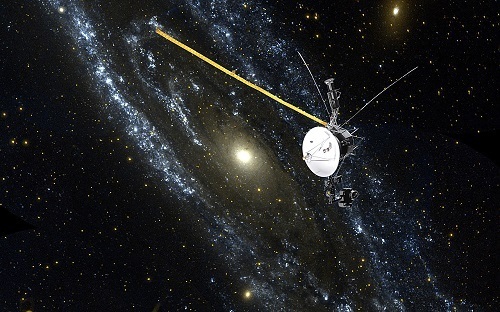
A trajectory change would increase only infinitesimally the faint chance that one of these spacecraft would someday be intercepted by another intelligent civilization, but the message of this maneuver is really to us. There is a certain magic in the idea that these venerable machines might one day be warmed by the light of another sun. In any event, I’m much in favor of Pioneer plaques, Golden Records, and One Earth Messages, as they remind us that our spacecraft are our emissaries as well as our scientific tools. How we conceive of them through the information they carry helps us gain perspective on ourselves, and shapes the context of all our future explorations. If we can do it, I’m all for giving the Voyagers one last, hard nudge into the unknown.






April 20, 2015
Transient Listening: A Caution
by James Benford
Searching for the faintest of signals in hopes of detecting an extraterrestrial civilization demands that we understand the local environment and potential sources of spurious signals. But we’ve also got to consider how signals might be transmitted, the burden falling on SETI researchers to make sense out of the physics (and economics) that constrain distant beacon builders. James Benford, CEO of Microwave Sciences and a frequent Centauri Dreams contributor, now looks at the problem in light of recent transients and discusses how we should move forward.

The recent activity on Perytons leads us to a major lesson. We have a vast microwave network all around us that can interfere with transient radio astronomy. Our cell phones, though not powerful, influence the stronger transmitters and antennas of the cell phone towers. Add to that the many Internet hubs, microwave ovens, wireless equipment and extensive communication webs. All these may have fast transients with features that are largely unreported.
Filtering out extraneous sources is very important in the broader context of radio telescope astronomy, especially for the growing field of transient radio astronomy. There are many types of possible astronomical transients: of course pulsars, but also magnetars, rotating radio transients (RRATs), gamma ray burst afterglow in radio, etc.
And there may be ETI beacons, which are likely to be transient as well. This may apply especially for the beacons I, and my coauthors Gregory and Dominic Benford, have explored in earlier papers. We argued on economic grounds (both capital costs and operating costs) that they are likely to be transient. [See SETI: Figuring Out the Beacon Builders and A Beacon-Oriented Strategy for SETI, as well as the citations listed at the end of this article].
Traditional SETI research takes the point of view of receivers, not transmitters. This neglects the implications of a simple fact: a receiver does not pay for the transmitter; the sender determines what to build.
But most radio astronomy observers are unfamiliar with the technologies and techniques of transmitters, whether it’s commercial electronic equipment, military equipment or SETI beacon builders.
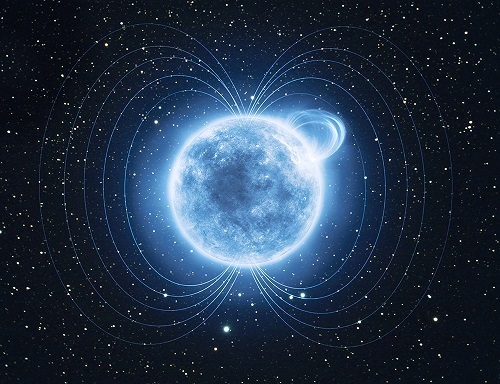
Image: Magnetar SGR 0418+5729 with a magnetic loop. Magnetars, a potential source of transients, are peculiar pulsars – the spinning remnants of massive stars – that are characterized by unusually intense magnetic fields. Astronomers discovered them through their exceptional behavior at X-ray wavelengths, including sudden outbursts of radiation and occasional giant flares. Credit: ESA/ATG medialab.
A Missing Piece to the Puzzle
A specific example: Identifying the source of Perytons at the Parkes radio telescope – the microwave ovens – is incomplete. It misses identifying a cause for the observed frequencies received following a descending curve, flattening a little at later times. That’s approximately like the ‘dispersion measure’ (DM) due to interstellar plasma. [see Perytons: A Microwave Solution].
How can that happen in a microwave oven? A jerked-open oven door cuts off the voltage V to the magnetron. The frequency emitted from a magnetron scales as V/B, with the magnetic field B fixed by a permanent magnet. Voltage is proportional to frequency (f~V), so emitted frequency falls as the voltage declines and turns off. The magnetron passes through several lower frequency modes, which explains why the intensity of the radiation varies up and down as modes wax and wane.
Electron emission in the magnetron also declines as the cathode cools. The emitted frequency thus mimics a dispersion measure. (Note that amplifiers, such as the klystrons within transmitters used in the Deep Space Network and planetary radars, won’t show such behavior because of the way they operate. All oscillators, such as magnetrons, can behave this way.)
A Parallel
Therefore there is a parallel between what has now been found about Perytons and what we found about SETI beacons: Five years ago we looked at them from the point of view of those who would build beacons, as opposed to those observers who presume that beacons are all designed around the observers’ convenience or requirements. Similarly, the searchers after Perytons didn’t understand microwave sources – such as microwave ovens – and therefore missed that possibility for some years. People who are doing radio astronomy are usually not conversant with microwave radiating technologies. Alas, in the paper the Swinburne group just published, they still say that the cause of the emissions is “obscure.” It isn’t. Knowledge of how magnetrons work would have led to understanding their “dispersion measure.”
Because of the increasing emphasis in radio astronomy on searching for transients of many varieties, the point of view has to change. Radio astronomers had best study the transient background in detail, to eliminate false positives in their search for unusual astrophysical events. And the Peryton episode is a reminder for SETI that every possible alternative has to be explored before fingers are pointed at an extraterrestrial explanation.
This could be a bit tedious, but it’s essential. And it could avoid future embarrassments. If it’s any consolation, any transmitting aliens hailing us may have considered this as well. Possible implications for our search strategies should be explored.
For more on the Benfords’ papers on beacons, see James Benford, Gregory Benford and Dominic Benford, “Messaging with Cost-Optimized Interstellar Beacons,” Astrobiology Vol. 10, No. 5 (2010), pp. 475-490 (abstract / preprint), and the same authors’ “Searching for Cost-Optimized Interstellar Beacons,” Astrobiology Vol. 10, No. 5 (2010), pp. 491-498 (abstract / preprint).






April 17, 2015
Exomoons: A Data Search for the Orbital Sampling Effect and the Scatter Peak
Exomoons continue to be elude us, though they’re under intense study. One detection strategy is called Orbital Sampling Effect, as explained in the article below. I’ll let Michael Hippke describe it, but the intriguing fact is that we can work with these methods using existing datasets to refine our techniques and actively hunt for candidates. Michael is a researcher based in Düsseldorf, Germany. With a background in econometrics, statistics and IT, he mastered data analysis at McKinsey & Company, a multinational management consulting firm. These days he puts his expertise to work in various areas of astrophysics, and most recently appeared here in our discussion of his paper on Fast Radio Bursts (see Fast Radio Bursts: SETI Implications?).
by Michael Hippke

Our own Solar System hosts 8 planets (plus Pluto and other “dwarf planets”), but 16 large moons with radii over 1,000km. And we have detected thousands of exoplanets – planets orbiting other stars – but not a single exomoon. The question of their existence is interesting, as some exomoons might in fact be habitable. Lately, there has been some speculation that, overall, there might be more habitable moons than planets in the universe. Consequently, we really want to know more about moons!
Moons are, by definition, smaller than their host planets, and thus harder to detect. Various search methods have been proposed – with the HEK project (Hunt for Exomoons with Kepler), led by David Kipping, being the most prominent team. A novel, promising method has been developed by René Heller in 2014, dubbed the “orbital sampling effect” (OSE). As with exoplanet transits, this method stacks many (dozens or ideally hundreds) of planet transits, and searches for the signature of a moon in this stack. While planet transit shapes are rather simple, the moon curves turn out the be very complex.
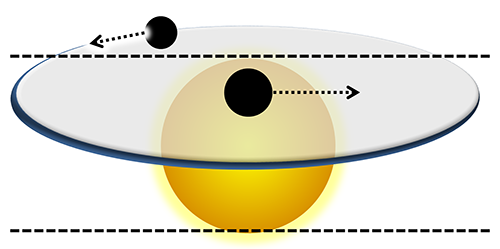
Image: A star with a transiting planet and its moon. The angled area shows the inclination of the moon orbit. Orbit positions beyond the dashed line are not undergoing transit, and are thus not observable.
In my recent work, I have processed data from the Kepler space telescope to search for this effect. I also worked with the “scatter peak,” an exomoon detection method described by Attila Simon (Konkoly Observatory, Hungary) and team in 2012. It is based on the fact that the geometrical exomoon configuration is very likely different during every exoplanet transit: On some transits, the moon might be ahead of the planet, on other transits behind it. When stacking many transits, at a given phase folded time, one gets a flux loss in some cases, and not in others. This results in increased scatter (photometric noise) when compared to out-of-transit times.
While the sole use of the scatter peak is problematic due to stellar noise, it can be used to confirm or reject certain signals. Not surprisingly, the struggle against stellar noise, instrumental jitter and other glitches has required the development of a complex statistical framework. While the Kepler data quality is at the very limit for exomoon hunting, a few very interesting results could be achieved.
The first result is sensitivity. What moons can we detect with Kepler and the OSE? Learning the answer to this will be useful for the assessment of future time-series photometry space missions, such as TESS or PLATO 2.0. With Kepler, the limit seems to be about 0.3 — 0.4 Earth radii for a moon to be detected, which is about the size of Ganymede. In many cases, where the host stars are dimmer, or noisier, only larger moons can be detected. Despite these limitations, my work shows that the OSE is a promising method, which will one day, with better data quality and/or processing, likely succeed and find moons!
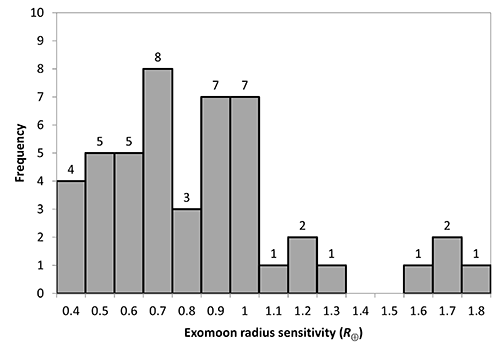
Image: The smallest radii detectable with the OSE in Kepler data are ~0.4 Earth radii. In many cases, the data and method only allows for the detection of larger moons. These are calculated limits, not real observations.
The second result is the ‘average moon’ effect. While no single moon could be detected, it is possible to “super-stack” a larger sample of planet-OSEs to estimate the average moon size in different samples. For very short-period planets with orbits shorter than about 15 days, no moons are seen. This is in agreement with stability arguments: The closer the planet to the star, the more the star “pulls” on the moon and tries to swallow it. The critical distance is not perfectly clear, but believed to be at ~15-day orbits. In my analysis, I find that the average moon signal comes up for periods over 35 days. In the sample of 35- to 80-day orbits, I find an average moon radius of about 2,000km (roughly like our moon). This estimate doesn’t tell how many planets actually have moons, or how many multiple moon systems are included in this average. It is for future studies (and telescopes) to determine this. But it is exciting that one can try.
The third result is about individual candidates. A small sample of planets shows prominent OSE-like signals justifying an in-depth analysis. It must be clearly said that, very likely, all of these will turn out to be false-positives. For some cases, it might even be possible to show that they cannot be moons, for example because some configurations are not stable over longer time frames. But this is not a bad result, for when we find false-positives, we can add the detection mechanism for these to our algorithm, and improve future searches.
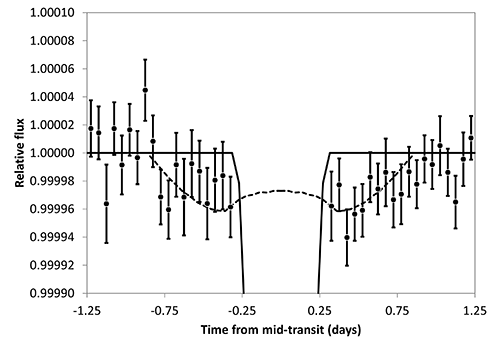
Image: Planet transit (straight line), moon effect due to the OSE (dashed line) and real datapoints (dots with error bars). In this case of Kepler-264b, the data are in favour of a moon interpretation, although this cannot be considered a detection, as detailed in the paper.
Personally, I would expect that the first moon(s) that will be found will be at the long (large/massive) end of exomoon distribution, as was the case for exoplanets. This comes from a selection bias: Large things are easier to see, and will thus be detected first. It will not mean that all moons are giants, as not all planets are Hot Jupiters (which were the first planets detected). Interesting times are ahead!
For more information, the paper is Hippke, “On the detection of Exomoons: A search in Kepler data for the orbital sampling effect and the scatter peak.” It has been accepted by the Astrophysical Journal for publication. A preprint is available.






April 16, 2015
G-HAT: Searching For Kardashev Type III
A new paper out of the Glimpsing Heat from Alien Technologies search (G-HAT) at Penn State is packed with fascinating reading, and I’m delighted to send you in its direction (citation below) for a further dose of the energizing concepts of ‘Dysonian SETI.’ Supported by a New Frontiers in Astronomy and Cosmology grant funded by the John Templeton Foundation, G-HAT has been studying whether highly advanced civilizations are detectable through their waste heat at mid-infrared wavelengths, a tell-tale signature posited by Freeman Dyson in the 1960s.
We now have the highly useful dataset of some 100 million entries gathered by WISE, the Wide-field Infrared Survey Explorer mission, to work with. G-HAT researcher Roger Griffith, lead author of the paper on this work, went through these data, culling out 100,000 galaxies that could be seen with sufficient detail, and searching for any that produced an unusually strong mid-infrared signature. Fifty galaxies do show higher levels of mid-infrared than expected, necessitating follow-up studies to determine whether natural processes are at work or, indeed, the functions of an extraterrestrial civilization. But no clear signs of alien technology appear.
G-HAT’s founder, Jason Wright, points to the significance of this new scientific result:
“Our results mean that, out of the 100,000 galaxies that WISE could see in sufficient detail, none of them is widely populated by an alien civilization using most of the starlight in its galaxy for its own purposes. That’s interesting because these galaxies are billions of years old, which should have been plenty of time for them to have been filled with alien civilizations, if they exist. Either they don’t exist, or they don’t yet use enough energy for us to recognize them.”
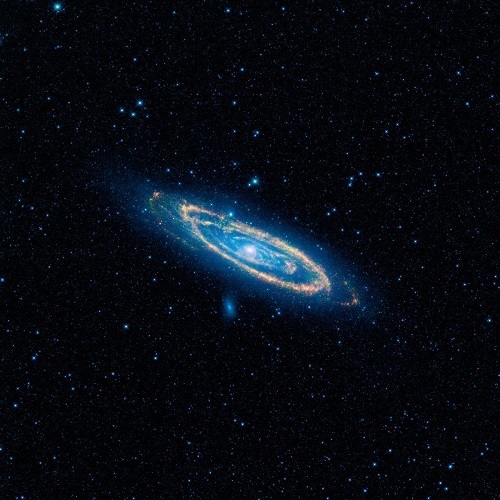
Image: A false-color image of the mid-infrared emission from the Great Galaxy in Andromeda, as seen by Nasa’s WISE space telescope. The orange color represents emission from the heat of stars forming in the galaxy’s spiral arms. The G-HAT team used images such as these to search 100,000 nearby galaxies for unusually large amounts of this mid-infrared emission that might arise from alien civilizations. Credit: NASA/JPL-Caltech/WISE Team.
Wright refers to the work as a ‘pilot study’ that will help the researchers tune up their methodologies to separate natural astronomical sources from what could be waste heat from an alien civilization. The team found some curiosities within our own Milky Way, including one cluster of objects that WISE registers strongly, but that appears black in visible light telescopes. Co-investigator Matthew Povich (Cal Poly Pomona) believes this to be a cluster of young stars inside a hitherto undiscovered molecular cloud. Another local find: A bright nebula around the star 48 Librae apparently flagging a huge dust cloud. Both will doubtless receive scrutiny from astronomers even as G-HAT itself moves on to study its own best galactic candidates.
Griffith and Cal Poly Pomona undergraduate Jessica Maldonado studied the astronomical literature to find which of the most interesting objects turned up by the survey had previously been studied. About half a dozen had received no previous scrutiny, a fact that does not surprise G-HAT co-investigator Steinn Sigurðsson:
“When you’re looking for extreme phenomena with the newest, most sensitive technology, you expect to discover the unexpected, even if it’s not what you were looking for. Sure enough, Roger and Jessica did find some puzzling new objects. They are almost certainly natural astronomical phenomena, but we need to study them more carefully before we can say for sure exactly what’s going on.”
That there is much for G-HAT to do should be obvious from the fact that using the abundant WISE data in the mid-infrared is a new direction for SETI. There are those who would argue, as Michael Hart did back in 1975, that given the age of the Milky Way, we should be aware of other civilizations if they indeed existed. Hart believed that any galaxy will become colonized in a relatively short time when compared to the overall age of the galaxy. Either there is no spacefaring species in a galaxy, or the galaxy in question quickly fills up with them.
Nikolai Kardashev classified civilizations in 1965 on the basis of the energies they could use, a Type II civilization being one capable of using the power of its host star’s entire luminosity. This is the now familiar realm of the Dyson sphere, intercepting the entire output of its star. We then move to a Type III civilization, one capable of using the stellar luminosity of an entire galaxy. Hart’s argument was that the emergence of a Type II culture is shortly followed by Type III. If interstellar flight is common, we should expect many Type III civilizations. The paper notes:
If Hart’s reasoning is sound, then we should expect that, unless intelligent, spacefaring life is unique to Earth in the local universe, other galaxies should have galaxy-spanning supercivilizations, and a search for K3’s may be fruitful. If there is a flaw in it, then intelligent, spacefaring life may be endemic to the Milky Way in the form of many K2’s, in which case a search within the Milky Way would be more likely to succeed. It is prudent, therefore, to pursue both routes.
Type II civilizations in our own galaxy should be detectable, and we’ve looked before at searches for the waste heat of the Dyson spheres such cultures might create. Richard Carrigan’s work on this score has been pioneering (see Toward an Interstellar Archaeology as an entry into other articles on the topic that are in the archives). Carrigan used data from IRAS (the Infrared Astronomical Satellite, launched in 1983), deciding out of 11,000 sources that the best of the Dyson sphere candidates he found were reddened and dusty astronomical objects.
The G-HAT paper, the third produced by the group, also points to the searches for Dyson spheres by Jun Jugaku and Shiro Nishimura, whose work in the 1990s found no Dyson spheres around the roughly 550 stars they surveyed within 25 parsecs. James Annis conducted a search for Kardashev Type III civilizations in the late 1990s and found no evidence for them, but mid-infrared surveys like WISE give us far more data within which to conduct such a search.
Thus these early results from G-HAT point to deepening study as the team refines its methods to make them sensitive to lower waste heat levels from extraterrestrial technologies. The currently reported work tells us that none of the galaxies resolved by WISE in this study contain Type III civilizations that are reprocessing 85 percent or more of the starlight of their galaxy into the mid-infrared. And as mentioned above, out of 100,000 galaxies, only fifty show a mid-infrared signature that could be considered consistent with reprocessing more than 50 percent of the starlight.
These fifty point to the further investigations ahead. As does this::
We also identify 93 sources with γ > 0.25 but very little study in the scientific literature. Three of these sources are MIR-bright [mid-infrared] and red galaxies that are essentially new to science, having little or no literature presence beyond bare mentions of a detection by IRAS or other surveys.
Here γ refers to thermal waste heat emitted by an object (waste heat luminosity), which is expressed as a fraction of the starlight available to the civilization. The paper explains that for waste heat temperatures in the 100-600 K range, values of γ near 1 would indicate that most of the galaxy’s luminosity was in the mid-infrared (now we are talking about the waste heat of a Type III technology). Values near 0 would imply that the value of any alien waste heat was small compared to the total output of the stars in the galaxy. The paper continues:
Verification that the MIR flux in all of these galaxies is predominantly from natural sources (e.g., through SED [Spectral Energy Distribution] modeling across many more bands than WISE offers or spectroscopy) will push our upper limit on galaxy-spanning alien energy supplies in our sample of 1 × 105 galaxies down to 50% of the available starlight. In the meantime, these are the best candidates in the Local Universe for Type iii Kardashev civilizations.
The paper is Griffith et al., “The Ĝ Infrared Search for Extraterrestrial Civilizations with Large Energy Supplies. III. The Reddest Extended Sources in WISE,” Astrophysical Journal Supplement Series Vol. 217, No. 2, published 15 April 2015 (abstract / preprint). A Penn State news release is also available.






April 15, 2015
Perytons: A Microwave Solution
Radio bursts scant milliseconds long that have been reported at the Parkes radio telescope in New South Wales — so-called ‘perytons’ — turn out to be the product of microwave ovens. The Case of the Puzzling Perytons, as Earl Stanley Gardner might have titled it, appeared in these pages earlier, with alliteration intact, when Jim Benford tackled it in Puzzling Out the Perytons. You’ll recall that Benford thought microwave ovens were involved, and now we learn that the Parkes team had independently reached the same conclusion before he arrived. Moreover, the authors of the Parkes paper had already embarked upon an investigation that now yields positive results.
Make no mistake, this is a useful finding, even if it has generated a certain degree of understandable banter. After all, we’re looking for emissions from deep space but fending off spurious signals generated by staff lunching on the grounds of the observatory itself. The larger picture, though, is that the kind of signals our radio telescopes work with are so infinitesimally small that they’re subject to myriad incursions from the sea of radiating objects all around us.
We need to know what these sources of interference are, and although it doesn’t have the same cachet as discovering a new astrophysical phenomenon, much less detecting the signature of an extraterrestrial civilization, something as mundane as tracing interference to a microwave oven is a step forward. Perytons have been reported back into the 1990s, in some ways acting like a signal from deep space, but in others (their persistent appearance in different fields of view), looking like the result of nearby interference from, perhaps, an aircraft or telescope component.
In fact, that characteristic wide-field detectability is a known screen that radio astronomers use to filter out local interference. Also looking suspiciously human was the fact that the 25 perytons reported in the literature occurred only during office hours and primarily on weekdays. The perytons, though, had something that set them apart from more normal sources of interference. They showed dispersion measures (DMs) that were roughly similar to genuine astrophysical signals, their swept frequencies mimicking signals that have moved through deep space.
For more on dispersion measures and their uses, see Fast Radio Bursts: SETI Implications?, which ran ten days ago in these pages. But as that article notes, we have to make a distinction between fast radio bursts (FRBs) and perytons, the former still enigmatic and evidently from non-local sources, the latter now understood to be the product of human technology. The Parkes authors are careful to make this distinction in the concluding paragraphs of their paper.
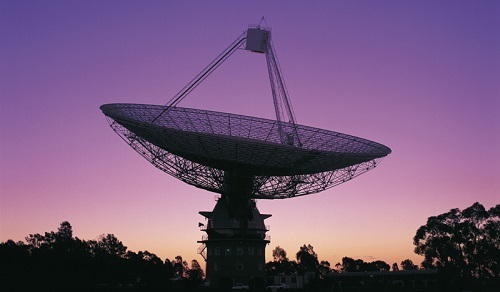
Image: The 64-meter radio telescope at the Parkes Observatory in New South Wales, Australia. Credit: CSIRO.
The paper on the Parkes work is “Identifying the source of perytons at the Parkes radio telescope” (citation below). Lead author Emily Petroff and team describe their use of radio frequency interference monitoring equipment at Parkes as well as the Australia Telescope Compact Array (about 400 kilometers north of Parkes) to chase down the culprit. In January, the team detected three perytons, syncing with the detection of the signals by the telescope itself.
What the RFI equipment detected were emissions in the frequency range 2.3 ~ 2.5 GHz consistent with the 1.4 GHz peryton event, indicating to the researchers that the 1.4 GHz millisecond bursts were associated with the episodes of 2.4 GHz emission. From the paper:
The 2.3 – 2.5 GHz range of the spectrum is allocated to “fixed”, “mobile” and “broadcasting” uses by the Australian Communications and Media Authority, and includes use by industrial, scientific and medical applications, which encompasses microwave ovens, wireless internet, and other electrical items. This suggests that the perytons may be associated with equipment operating at 2.3 ∼ 2.5 GHz, but that some intermittent event or malfunctioning, for example, from the equipment’s power supply, is resulting in sporadic emission at 1.4 GHz.
We also learn that although peryton detections at 1.4 GHz coincide with episodes where there is a higher-frequency emission, the higher frequency emission can occur without an associated peryton. The RFI monitor data tell the tale: Several hundred spikes of emission at 2.3 ~ 2.5 GHz occurred during the investigation period. The events clustered in time of day and tended to occur during the daytime, a finding consistent with microwave oven use or the use of other electrical equipment. It remained to attempt the ‘recreation’ of a peryton to test the theory.
Tests in February and March involved running the three microwaves in close proximity to the telescope at both high and low power. Details are in the paper and I won’t go further into them other than to note that the decisive moment evidently came on the 17th of March, when the microwave cycle was interrupted by opening the door. The paper describes three bright perytons produced from the staff kitchen microwave at times exactly coinciding with the opening of the microwave oven door.
Looking at earlier peryton detections, the authors found that of the 46 perytons detected at Parkes since 1998, more than a third of the total occurred within a short period on a particular day in 1998. Again, the microwave seems clearly implicated in a specific usage scenario:
…we find that indeed eight of the 15 intervals between consecutive events fall within the range 22.0+/-0.3 seconds, which is exceedingly unlikely to have been produced by manually opening the oven. Rather, we believe that the operator had selected a power level of less than 100%, causing the magnetron power to cycle on and off on a 22-second cycle, the period specified in the manufacturer’s service manual and confirmed by measurement. It appears likely that over this seven-minute period the oven produced a peryton on all or most completions of this 22-second cycle but that the operator stopped the oven manually several times by opening the door, each time restarting the 22-second cycle.
In other words, the oven’s magnetron can push out a signal when the door is opened prematurely — the magnetron is still in its shut-down phase and is producing emissions. The staff kitchen and visitors center at the observatory are the sites implicated in peryton production.
So we have three new peryton detections, allowing the researchers to correlate them with strong local emissions at 2.3 ~ 2.5 GHz, and further tests that show that perytons can be generated with microwave ovens on the site. The authors end the paper by stressing that the strong indications that perytons are man-made do not apply to fast radio bursts (FRBs), which they believe are of astronomical origin. In particular, FRB 010724, the so-called ‘Lorimer Burst,’ is not consistent with the peryton data. The authors declare it a genuine FRB, not a peryton.
The paper is Petroff et al., “Identifying the source of perytons at the Parkes radio telescope,” submitted to Monthly Notices of the Royal Astronomical Society (preprint). Nadia Drake does a fine job with the story for National Geographic in Rogue Microwave Ovens Are the Culprits Behind Mysterious Radio Signals.






April 14, 2015
New Horizons Message Update
If you want to send a message to the stars, Jon Lomberg is the man to consult. A gifted artist and creator of the gorgeous Galaxy Garden in Kona, Hawaii, Lomberg may be most famous for his frequent work with Carl Sagan, including the celebrated Cosmos series. But it’s his involvement with the Voyager Interstellar Record, a project for which he served as design director, that makes him so uniquely qualified to embark on a new messaging effort, the One Earth: New Horizons Message project.

Let’s talk about Voyager and how the new message differs. 115 images and 27 musical selections went into the Voyager record, along with abundant audio of the life and natural sounds of our planet. The 12-inch gold-plated copper disk included spoken greetings in fifty-five languages beginning with Akkadian (a language of ancient Sumer) and ending with Wu, a modern Chinese dialect. The ninety minutes of music can be played at 16 ⅔ revolutions per minute using a cartridge and needle enclosed within the record’s protective jacket.
We knew that the Voyagers would eventually leave the Solar System, which was why putting a message from humanity on them suggested itself. In the absence of a current mission being built to do the same thing, reasoned Lomberg, why not upload a message to the one we already have in progress, the New Horizons probe to Pluto/Charon? The plan is to create the message not through a small committee but a worldwide crowd-sourced effort in which people will build a self-portrait of Earth. Over 10,000 people from more than 140 countries signed the original petition urging NASA to send the Message. The team hopes that thousands more will submit ideas for its content.
Image: Jon Lomberg, project director for the One Earth: New Horizons Message effort.
If the Voyager record carried pictures and sound, we could do the same for New Horizons, sending all of our content to the spacecraft once it has completed its encounter with Pluto/Charon and any later Kuiper Belt Object the spacecraft may be able to study. Software and 3D files are another possibility, limited only by the memory constraints of the New Horizons onboard computers, which have been under active study by the One Earth technical team. Unlike the Voyager and earlier Pioneer messages, this is a message that can be updated and improved as long as the spacecraft is in communication with the Earth, which could be a matter of decades.
A news release dated today announces the start of an online fundraising campaign designed by Fiat Physica, which specializes in raising money for science projects. Readers are encouraged to visit the site to view a video on the project. From the release:
We have determined that the message is technically feasible. We are confident of a message lifetime of tens of millennia in the computer memory, and can take steps to increase the message’s durability beyond that. Our submission website will be constructed by the iScience group at the University of Koblenz, under the direction of Ulf-Dietrich Reips. One main goal of the fundraising is to gather the funds required to build this site. We hope to have the submission site ready before the July encounter. We will announce soon when the project is ready to receive submissions.
Messages like those aboard Voyager and New Horizons are designed for the people of Earth as much as any extraterrestrial beings that may, in some remote future, encounter them. Having completed its mission, New Horizons will leave the Solar System in the general direction of Sagittarius, toward the center of the Milky Way, though not in the direction of any specific star. The odds of interception are obviously minute, and the data will be sent to the spacecraft on standard radio links connecting Earth with all NASA spacecraft, representing no increase in the risk of detection beyond messaging traffic that is already in progress. In other words, the One Earth Message, although designed to be found by aliens, almost certainly will not be.
Why, then, send it in the first place? Lomberg and his eighty-strong advisory board believe that creating a message to represent all of us is a priceless educational and cultural opportunity, allowing us to step back and view our ‘pale blue dot’ in a whole new way. Shaping such a message so as to be intelligible to non-humans is itself a challenge with abundant learning opportunities. Alan Stern, principal investigator for New Horizons, is a strong supporter of the One Earth Message, as is the New Horizons team at Johns Hopkins Applied Physics Laboratory. Please have a look at the One Earth Message site and consider getting involved.
“This will be a message from and to the Earth,” says Jon Lomberg. “The very act of creating it will be a powerful reminder that we all share the same, small planet. We truly are one Earth.”





April 13, 2015
Call for Participation: TVIW 2016
I like the theme of the just announced 2016 iteration of the Tennessee Valley Interstellar Workshop. Set in Chattanooga, TN, the meeting will convene at a local landmark, the Chattanooga Choo-Choo Hotel, which is actually built around the old railroad station made famous in the Glenn Miller tune of the same name. What better way to describe the upcoming event than what the group has chosen: “From Iron Horse to Worldship: Becoming an Interstellar Civilization.” The Chattanooga event follows two previous meetings in Oak Ridge and one in Huntsville, AL, all of which I’ve had the pleasure of attending.
The level of engagement I’ve found at TVIW has made all the meetings a success, beginning with the first, in Oak Ridge, back in 2011. That one sticks in my mind because of the intense fog that hung over the mountains as I drove in the evening before. The discussions and presentations were stimulating throughout, with an emphasis on more engagement with audience members than in a formal conference. Last year, this included breakout sessions on specific topics, including SETI, worldship ecosystems and their biological implications, reverse engineering starships from science fiction, and safety issues in deep space systems.
“We are setting the table for serious discussion about humanity’s future as an interstellar civilization,” says John Preston, TVIW’s president. “We want to provide fresh insights into the early challenges that we face while developing technology and prepare for long-term space travel.”
TVIW is now seeking proposals for interdisciplinary working tracks and plenary talks, along with other content such as posters, displays of art and models, demonstrations and panel discussions. Its news release about the upcoming event says that the organization ‘prefers content that is well-grounded, near-term, and practical, and that promotes future collaboration amongst its participants.’ What follows is TVIW’s Call for Participation, reproduced verbatim and with links to guide those interested in getting involved. The Tau Zero Foundation is pleased to be one of the sponsors of the Chattanooga meeting.
“From Iron Horse to Worldship: Becoming an Interstellar Civilization”
The Tennessee Valley Interstellar Workshop (TVIW) hereby invites participation in its 2016 Meeting, to be held from Sunday, February 28 through Wednesday, March 2 in the historic Chattanooga Choo Choo Hotel in Chattanooga, Tennessee. We are seeking proposals for working tracks, plenary talks, and any other content.
Working Tracks are collaborative, small-group discussions about a set of interdisciplinary questions on an interstellar subject. Proposals for Working Tracks are due on June 15, 2015. Once proposed, development of candidate tracks will continue until August 16, 2015. See the web site for full details.
We assume the proposer(s) will be the Working Track’s technical lead and need not act as facilitator or moderator. Each Track will comprise a few hours of structured discussion and work on Monday and Tuesday during the Meeting. We expect participants in each Track to have prepared in advance for the Meeting, so that we will have productive conversations during our short time together. We anticipate that Tracks will extend existing collaborations or become the start of new collaborations after the Meeting. As with our 2014 Meeting, we expect reports from our Tracks to appear as Comments in JBIS.
Submit a Working Track proposal
https://www.tviw.us/event/tviw-2016/propose-working-track
Plenary Talks include traditional papers, lectures, and presentations. Proposals are due on August 16, 2015. Papers should be for original work that has not been previously published. The schedule allocates 20 minutes for each talk followed by 5 minutes of Q&A. Talks will be recorded on video for later distribution. Certain papers may be selected for submission to professional publications, such as JBIS.
Submit a Plenary Talk proposal
https://www.tviw.us/event/tviw-2016/propose-plenary-talk
Other Content includes anything not explicitly mentioned above. This category may include posters, displays of art or models, demonstrations, seminars, panel discussions, interviews, or public outreach events. Proposals are due on August 16, 2015. Be creative!
Submit an Other Content proposal
https://www.tviw.us/event/tviw-2016/propose-other-content
The Program Committee will send out all acceptances and rejections no later than November 1, 2015. Some decisions may occur sooner than this deadline.
TVIW is a group of interstellar enthusiasts who work together to take practical, near-term steps to advance humanity’s progress toward becoming an interstellar civilization. Each TVIW Meeting is an opportunity for face-to-face collaboration about interstellar topics such as exploration, communication, and human expansion. The field of interstellar studies has been heavy with science and technology, yet going to the stars must involve and engage all aspects of human society. TVIW is interested in all fields that can contribute toward this goal and therefore encourages proposals from the social sciences, humanities, and arts. Participants are encouraged not only to present original concepts but to develop these into active projects and continuing research. The Meeting is a time for thought-provoking ideas, stimulating discussions, and boundless optimism about a future that one day will be within humanity’s reach.
Let’s have a great Meeting!
Les Johnson
General Chairman, 2016 Tennessee Valley Interstellar Workshop
Contact the Program Committee
program-committee-2016@tviw.us
TVIW Web Site
https://www.tviw.us
JBIS abbreviates Journal of the British Interplanetary Society.
The TVIW is incorporated in the State of Tennessee as a public-benefit, non-profit scientific education organization, recognized as tax-exempt under chapter 501(c)(3) of the US Internal Revenue Service. Contributions to TVIW are tax-deductible to the extent provided by law.





Paul Gilster's Blog
- Paul Gilster's profile
- 7 followers



